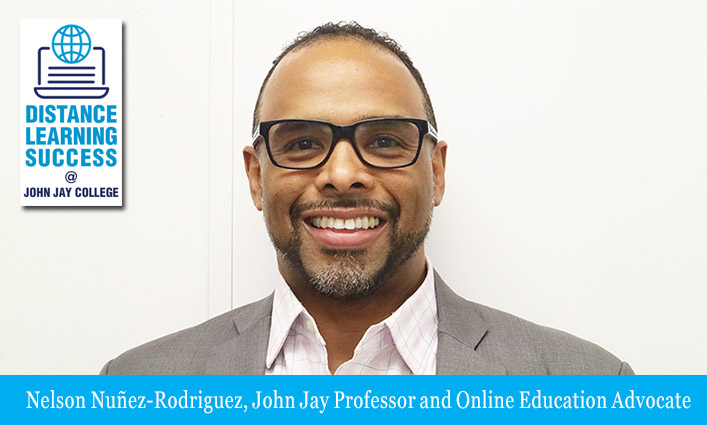
Nelson Nuñez-Rodriguez, a professor in the Department of Sciences at John Jay, may be new to the distance learning environment, but he’s embracing the change, seeing it as a growth opportunity for all involved. “I’ve been teaching the sciences for over two decades, but this is the first time I’ve created lectures for remote learning,” he concedes. “For faculty, like myself, who have never taught in the world of remote learning, it’s an opportunity to expand our educational toolkit and connect with students in different ways. I’ve tried to learn as much as I can about the features and programs available to us. I want to make sure I have helpful strategies in place to make the transition easier for my students.”
“By logging on to Blackboard, our students are showing up and saying, ‘we’re here and ready to learn.” —Nelson Nuñez-Rodriguez
Bringing Classroom Elements Online
For his first distance-learning class Nuñez-Rodriguez was excited to see students attending. “I logged on and to my great relief all 45 students were there waiting for me. It moved me so much. By logging on to Blackboard, our students are showing up and saying, ‘we’re here and ready to learn,’” says Nuñez-Rodriguez, who is doing his best to maintain a sense of normalcy by bringing in-classroom elements, online. “I know I can’t reproduce the in-classroom feel completely online, but I am trying to reproduce some of what I do in the classroom in the online format.” One such element is a question and answer period, where he poses a question for the class and then gives them 24 hours to provide him with their best answer. “Given the current circumstances, students crave structure, they want a routine they’re familiar with.”
Providing Flexibility for Students
While Nuñez-Rodriguez currently employs the synchronous approach, where class on Blackboard begins and ends at a certain time, he’s keenly aware that implementing a set schedule for remote learning doesn’t work for everyone and is exploring different ways to apply asynchronous learning in the virtual environment. “Flexibility will be the key to our students’ success. I’ve had students email me and ask if they can complete the class work within a 24-hour time frame instead of having to start at a precise time because they need flexibility,” says Nuñez-Rodriguez, who started saving sessions so students could go back to any lesson at their convenience. “A lot of our students are having to share their computers or laptops with multiple people at home, so they may not have access at the time you’re running the class. Some are having to take care of siblings, while others don’t have reliable internet,” he adds, acknowledging some of the challenges students face. “We professors need to be aware of what our students are dealing with and work with them so they can succeed.”
“A lot of our students are having to share their computers or laptops with multiple people at home, so they may not have access at the time you’re running the class.” —Nelson Nuñez-Rodriguez
Checking In with Students
To fully understand the obstacles students are facing Nuñez-Rodriguez regularly checks in with his students. “I spend a few minutes at the start of each class session asking how they’re doing, asking how their families are navigating through this difficult time, and letting them know they can email me with any questions or concerns they have,” he explains, pointing to Blackboard chat and discussion forums as additional avenues of communication. “It's about promoting different ways of engaging with our students and providing opportunities for them to communicate with us and with one another. They are missing that social engagement on campus, so it’s important to think of different ways to get them to communicate.”
Promoting a Collaborative Environment
One way to easily increase student engagement is to turn on certain features in Blackboard. During his teaching sessions, Nuñez-Rodriguez turns on the “chat” feature, enabling students to participate via text while the class is happening in real time. “Students can ask me questions, have class discussions, and even post emojis to provide classmates with positive feedback while the class is live,” says Nuñez-Rodriguez, who is also exploring the possibility of creating group assignments through the platform. Communicating through text is also providing those who opt to remain quiet in class, an opportunity to shine. “Remote learning enhances participation on a level you don’t see in person,” he says. “I have students who normally don’t speak up in class, participating now because they’re more comfortable communicating via text. It’s one of the great positives of distance learning. I’m also seeing students engage with one another to a greater degree.”
“Remote learning enhances participation on a level you don’t see in person.” —Nelson Nuñez-Rodriguez
Planning the Coursework Ahead
When it comes to the rest of the semester, Nuñez-Rodriguez says he’s keeping things simple and creating space for change. “I’ve provided students with an adjusted syllabus and as the time goes on, if we find it needs to be readjusted again, we’ll readjust it,” he says, citing pushing back exam dates to make room for the transition period. “I’m setting smaller weekly expectations as opposed to a larger semester one, because I want our students to focus on ‘now.’ I want them to give their all in today’s class session and do the best they can in it,” he adds, pointing to the resiliency of our students. “John Jay students are incredibly smart and responsive. They show up to each class ready to learn. And it’s a pleasure for me to be there, to be part of their academic journey, and to help them in any way I can.”



